How to Play Pickleball Doubles: Rules | Scoring I Positioning
Pickleball doubles offers a thrilling and dynamic mode of play that appeals to many enthusiasts of the sport. Whether you are just starting or have already mastered the singles game, grasping the specific rules and strategies of doubles play is vital for excelling on the court. This guide will provide you with a thorough understanding of how to play pickleball doubles effectively, covering everything from fundamental rules to more sophisticated tactics. Ready to learn? Let’s get started!
Pickleball Doubles Rules – How to Play the Game
The rules of pickleball doubles are similar to those of singles play, with a few key differences. In doubles, a pair of players team up to challenge another duo. The goal is consistent: earn points by striking the ball over the net into the rival’s court while avoiding any faults.
However, doubles play introduces additional rules and strategies that make the game more dynamic and strategic.
See Also: How Long is a Pickleball Game
Basic Court Positions and Roles in Doubles
In pickleball doubles, each player has a specific role and position on the court. Proper court positioning is crucial for maximizing control of the court and ensuring effective teamwork. Here are the basic court positions and roles for the serving and receiving teams:
- Serving Team: The serving player stands behind the baseline and delivers the serve, while the partner stands near the baseline, ready to receive the opponent’s return. The serving player’s role is to serve the ball accurately and initiate offensive plays, while the partner’s role is to anticipate the return and maintain optimal court coverage.
- Receiving Team: The player receiving the serve remains close to the baseline to respond, while their partner takes a position near the kitchen line, directly facing the server. The receiving player’s goal is to keep the serving team pushed back and create challenging shots, while the partner supports the return and transitions to the kitchen line for net play.
Defensive Strategies and Positioning
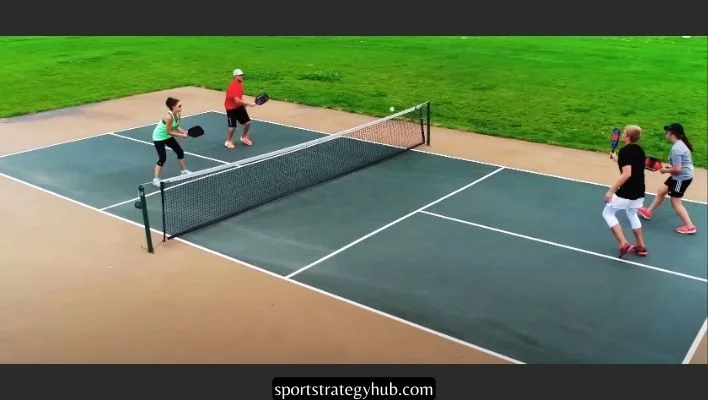
Defense is a critical aspect of pickleball doubles. Proper positioning and coordination with your partner can help you effectively defend against your opponents’ shots and maintain control of the game. Here are some defensive strategies and positioning tips for doubles play:
- Move Together with Your Partner: Coordination and synchronized movement are key in doubles pickleball. Move together with your partner to cover more ground and minimize gaps in court coverage. Communicate with each other and anticipate your partner’s movements to effectively defend against your opponents’ shots.
- Get to the Kitchen Line After Return-of-Serve: After returning the serve, quickly move forward to the kitchen line. This position allows you to dominate the net and put pressure on your opponents. The kitchen line is a strategic position for intercepting shots and setting up offensive plays.
- Always Communicate with Your Partner: Clear communication is crucial in doubles play. Ensure ongoing communication with your partner regarding positioning, shot choices, and strategic planning. Staying connected allows you to synchronize your movements and make quick decisions on the court.
Offensive Strategies and Positioning
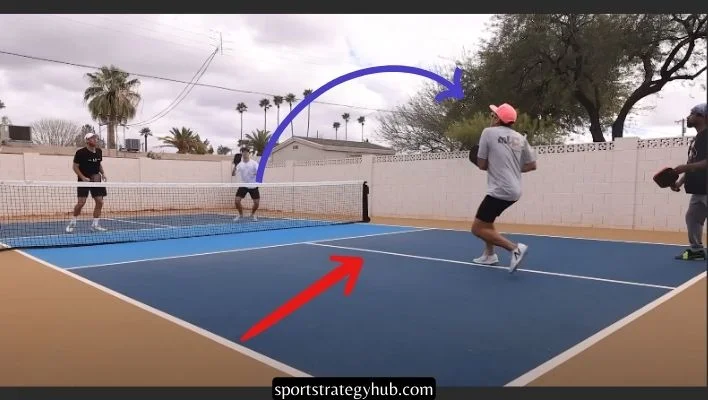
Creating opportunities for scoring and applying pressure on opponents are key elements of offensive play in pickleball doubles, requiring strategic shot placement. Here are some offensive strategies and positioning tips for doubles play:
- Move Back to Play Defense: While offense is important, it’s crucial to know when to transition to a defensive position. If your opponents hit a strong shot or put you on the defensive, move back to a defensive position and reset the rally. This strategy places you in a stronger position to manage your opponents’ shots and keep control of the game.
- Aim Between Your Opponents: When attacking, aim your shots between your opponents. This strategy creates confusion and forces them to make split-second decisions. By targeting the gap between your opponents, you increase the chances of scoring and putting your opponents on the defensive.
Serving Variation: Drop Serve
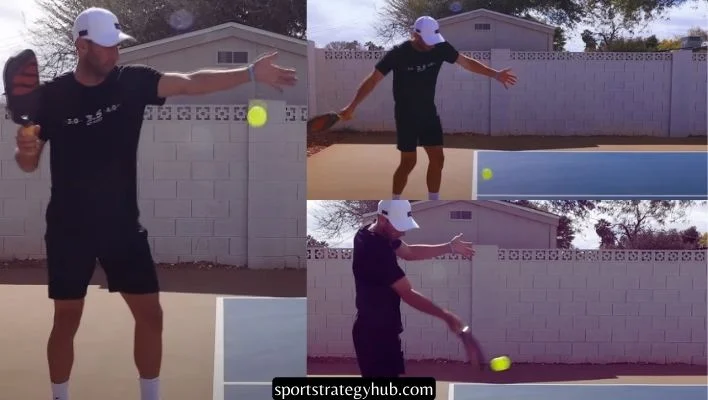
In doubles play, you have the option to use a drop serve, which can add an element of surprise to your game. The drop serve requires letting the ball fall to the ground and striking it as it bounces.
Consider these essential points when employing the drop serve:
- The server has the option to either drop the ball from their hand or roll it off the paddle face.
- The ball is allowed to bounce anywhere as long as the server keeps its feet behind the baseline.
- The ball should neither be forcefully slammed down nor thrown into the air before it hits the ground.
The drop serve can be a valuable tool in your arsenal, allowing you to mix up your serving strategy and catch your opponents off guard.
What Makes Positioning So Important for Doubles?
Effective placement is essential for achieving success in doubles pickleball. It improves coverage of the court, minimizes mistakes, and boosts collaborative efforts. When you position yourself thoughtfully during play, it allows you and your partner to compensate for each other’s weaknesses, keep your opponents under pressure, and devise offensive plays through well-coordinated shots. Enhanced court coverage results in faster response times, improved decision-making in shot selection, and less exposure to risks. Positioning should be dynamic, adjusting to the flow of the rally to meet the ball appropriately, rather than adhering rigidly to preset guidelines.
Doubles Pickleball Scoring
Understanding the scoring system in doubles pickleball is crucial for keeping track of points and determining the outcome of a game. In doubles play, there are two common scoring methods: side-out scoring and rally scoring.
See Also: How to score pickleball
Side Out Scoring
Side-out scoring, also referred to as traditional scoring, stands as the predominant method utilized in pickleball doubles matches. In side-out scoring, points can only be earned by the team that is serving. The receiving team cannot score points and can only win a point when they earn the right to serve.
Here’s the mechanism of side-out scoring:
- Every player on the serving team has an opportunity to serve and earn points until they commit a fault, except during the opening service sequence of each new game.
- Each side-out begins with the first serve executed from the right/even court.
- After scoring a point, the server transitions to the opposite side and commences the subsequent serve from the left or odd court.
- The server switches sides after each scored point until they make a fault, leading to a loss of serve for the initial server.
- Once the initial server loses the serve, it shifts to its partner, who serves from the appropriate courtside, except during the first service sequence of the game.
Rally Scoring
Rally scoring is an alternative scoring method used in some recreational and tournament settings. In rally scoring, both the serving and receiving teams have the chance to earn points. Each rally or exchange of shots results in a point being awarded to one of the teams, regardless of which team served.
Here’s how rally scoring works:
- Points are awarded to the serving or receiving team based on the outcome of each rally.
- The serving team continues to serve until the receiving team wins a rally and earns the serve.
- During their serving turn, the receiving team also has the opportunity to score points.
Rally scoring adds a different dynamic to the game, as every rally has the potential to impact the score.
Traditionalist View
Some traditionalists prefer side-out scoring because it rewards strong serving and strategic play. They argue that it adds a layer of strategy to the game and emphasizes the importance of earning the right to serve.
Pickleball Scoring Change Advocates
Supporters of rally scoring claim that it adds excitement and speeds up the game. They believe that rally scoring keeps both teams engaged throughout the match and allows for more frequent score changes.
Ultimately, the choice between side-out scoring and rally scoring may depend on personal preference or the specific rules of a tournament or league.
Volleys
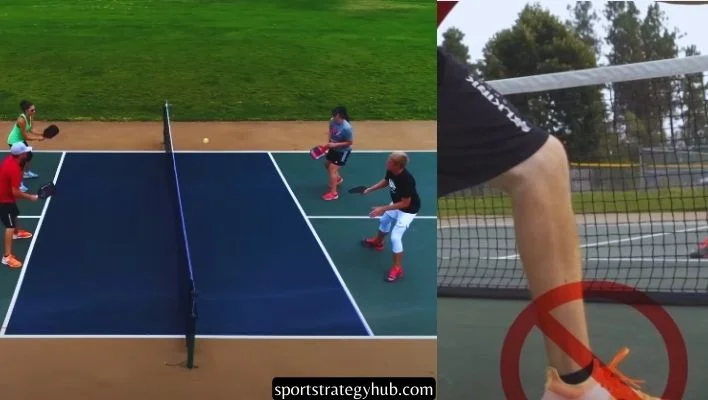
Volleys are an essential part of pickleball doubles and can be a powerful offensive weapon. A volley involves striking the ball directly from the air before it touches the ground. In doubles, players frequently perform volleys close to the non-volley zone, commonly referred to as the kitchen.
Here are some key points to keep in mind when executing volleys in doubles pickleball:
- Both feet must be behind the non-volley zone line when hitting a volley.
- Once you hit a volley, you must ensure that your momentum does not carry you into the non-volley zone.
- Volleys can be aggressive shots aimed at your opponents’ feet or gentle shots known as drop shots, which can catch your opponents off guard.
Mastering volleys in doubles play can give you a significant advantage by keeping your opponents on their toes and allowing you to control the pace of the game.
When Can You Enter the Non-Volley Zone?
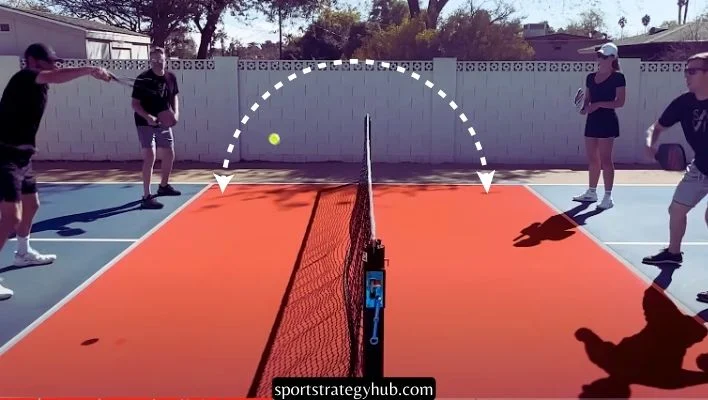
The non-volley zone, or the kitchen, plays a vital role in doubles pickleball. It spans the space from the net to the non-volley line. Knowing the rules for entering the non-volley zone is crucial for maintaining fair play and preventing faults as a player.
Here are the main rules for entering the non-volley zone in doubles play:
- You must not step into the non-volley zone to execute a volley or any shot until after the ball has bounced.
- You must ensure that your momentum does not move you into the non-volley zone after executing a volley.
- You are allowed to enter the non-volley zone if the ball bounces outside this area before you strike it.
Staying mindful of the rules regarding the non-volley zone will help you avoid faults and maintain fair play during your doubles matches.
What is Pickleball’s Double Bounce Rule?
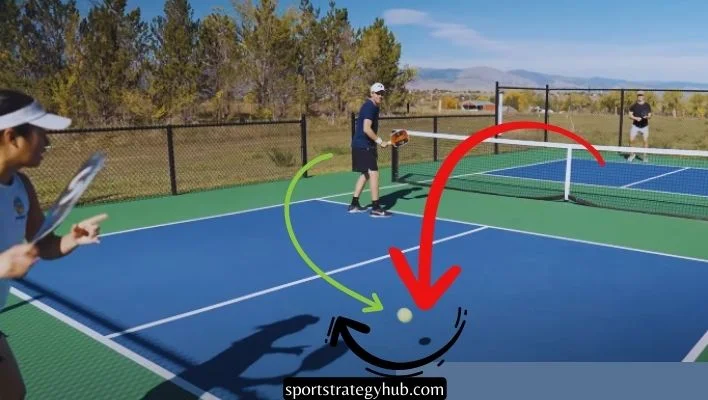
The double bounce rule is a crucial component of pickleball, especially in doubles. It requires that the ball must bounce once on each side of the net before players can start volleying. This rule fosters extended rallies and thoughtful shot placement.
Here’s the breakdown of how the double bounce rule is applied:
The team that serves must wait for the ball to bounce once following the return before they can hit it. Similarly, the team receiving the serve must also let the ball bounce once before returning it. Once these initial bounces are out of the way, both teams are free to volley the ball without further bounces. Incorporating this rule introduces a strategic layer to pickleball, demanding careful positioning and foresight into the opponents’ moves.
Line Calls
In pickleball doubles, making accurate line calls is essential for fair play and good sportsmanship. Line calls determine whether a shot is considered in or out of bounds and can impact the outcome of a rally or point.
Here are some guidelines for making line calls in doubles play:
- Make line calls in good faith, based on your best judgment of where the ball landed.
- If you’re uncertain about a line call, it’s best to lean towards fairness and call the shot in.
- Communicate with your partner and opponents to ensure everyone is on the same page regarding line calls.
- If there is a dispute about a line call, it’s best to resolve it through open communication and fair play.
Maintaining good sportsmanship and making accurate line calls contribute to a positive playing environment and an enjoyable pickleball experience.
Faults
Knowing what counts as a fault in doubles pickleball is essential for playing the game properly and steering clear of penalties. A fault occurs when a player or team violates a specific rule, resulting in the loss of a point or the loss of the serve.
Here are some frequent faults in doubles pickleball:
- Hitting the ball out of bounds.
- Striking the ball into the net or not managing to get the ball over the net with a shot.
- Entering the non-volley zone to hit a volley or any shot before the ball has bounced.
- Violating the serving rules, such as serving above the waist or not serving diagonally.
Knowing the different types of faults and avoiding them will help you play pickleball doubles fair and square.
Equipment
Having the proper equipment is crucial for playing doubles pickleball. Here are some considerations when it comes to equipment for doubles play:
- Paddles: Choose paddles that suit your playing style and skill level. Paddles specifically designed for doubles play may offer additional control and maneuverability.
- Balls: Use pickleballs approved for tournament play. Opt for balls that provide consistent bounce and durability, allowing for enjoyable rallies and fair play.
- Court Shoes: Opt for comfortable court shoes that offer both stability and traction on the court. Good footwear helps you move quickly and confidently during matches.
- Protective Gear: Consider wearing protective eyewear to safeguard your eyes from potential injury during fast-paced rallies.
Having the right equipment guarantees comfort and peak performance in doubles pickleball.
Court Size
The size of the pickleball court is the same for both doubles and singles play. The court spans 20 feet in width and 44 feet in length for doubles matches. Both sides of the non-volley zone also extend 7 feet from the net, maintaining the same dimensions
Understanding the dimensions of the court and the non-volley zone is crucial for proper positioning and gameplay in pickleball doubles.
Court Positioning
Effective court positioning is key to success in pickleball doubles. Here are some strategies for positioning yourself and your partner on the court:
- Stay near the baseline to cover a larger area and have more time to react to shots.
- Move towards the kitchen line for net play and to put pressure on your opponents.
- Anticipate your partner’s movements and communicate to ensure optimal court coverage.
- Shift positions based on the game situation, alternating between offense and defense.
Strategically positioning yourselves and coordinating your movements can effectively cover the court, optimizing your chances of winning points.
Pickleball Doubles vs. Pickleball Singles
Pickleball doubles and singles have distinct characteristics that make each style of play unique. Here’s a comparison of the differences between doubles and singles play in pickleball:
Rule Differences
The rules of pickleball doubles and singles are mostly the same, with a few key differences. In doubles play, there are specific regulations governing court positioning, serving order, and the non-volley zone. Understanding these rule differences is essential for playing pickleball doubles correctly.
Skill Set Differences
Doublesplay highlights the importance of teamwork, communication, and covering the court effectively. In doubles, players often need to coordinate their movements, anticipate their partner’s shots, and strategize together. Singles play, on the other hand, requires more individual skill and agility, as players have more court to cover on their own.
Gameplan Differences
The gameplan in doubles play often revolves around setting up offensive opportunities through coordinated shots and strategic positioning. Doubles players may focus on attacking the opponents’ weaknesses and exploiting gaps in their court coverage. In singles play, the gameplan may involve more aggressive shot-making and individual strategy to outmaneuver the opponent.
Which is More Physically Demanding: Doubles or Singles Pickleball?
The physical demands of pickleball doubles and singles can vary based on factors such as court coverage and game pace. Doubles play requires more lateral movement and coordination with a partner, which can be physically demanding. Singles play, though covering a larger court, may involve more intense running and individual agility. The physical demands vary based on the player’s style and the level of competition they face.
conclusion
In conclusion, pickleball doubles offers a unique and exciting way to play the sport. Understanding the rules, strategies, and specific positioning for doubles play can elevate your game, leading to a rewarding experience on the court. Whether you’re a beginner or a seasoned player, doubles pickleball provides an opportunity for teamwork, communication, and strategic play. So grab your partner, step onto the court, and have fun playing pickleball doubles!
See Also: How to play pickleball on a tennis court
